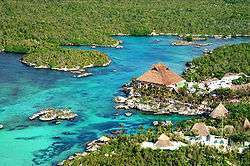Xel-Ha Park
 Xel-Há Inlet | |
| Location | Km. 240 Carretera Chetumal-Puerto Juárez local 1 y 2 módulo B, Quintana Roo, Mexico |
|---|---|
| Coordinates | 20°19′2.22″N 87°21′24.55″W / 20.3172833°N 87.3568194°WCoordinates: 20°19′2.22″N 87°21′24.55″W / 20.3172833°N 87.3568194°W |
| Owner | Promotora Xel-Ha S.A. de C.V. (subsidiary of Experiencias Xcaret Group) |
| Website | http://www.xelha.com/ |
Xel-Ha Park (Parque Xel-Há) is a commercial aquatic theme park and ecotourism development located on the Caribbean coast of the state of Quintana Roo, Mexico, in the municipality of Solidaridad. It is part of Xcaret Experiencias Group which also owns the Xplor Park, Xcaret Park, and Xenses Park; as well as the Xichen, Xenotes, and Xoximilco tours and activities. It is situated within the "Riviera Maya", a region promoted as a tourism corridor along Highway 307. It is approximately 240 kilometres (149 mi) to the north of Chetumal, and 122 kilometres (76 mi) south of Cancun.[1] The park is named after the site of Xelha, an archaeological site of the pre-Columbian Maya civilization, part of which is located within the lands leased to the park. The Maya site of Tulum is nearby, some 13 kilometres (8.1 mi) to the south.
From 2010 to 2015, Experiencias Xcaret has been recognized as one of The Best Mexican Companies (Las Mejores Empresas Mexicanas), a recognition promoted by Banamex, Deloitte México and Tecnológico de Monterrey.[2]
History
The theme park was founded in 1984,[3] and is under the management and marketing of the Mexican-owned Experiencias Xcaret Group.[4]
The park is centered around the natural inlet and lagoon, which is promoted as one of the main attractions of the park that forms with the flow of the river through rocks mixing salty waters with fresh underground water currents.
The inlet of Xel-Há is a natural aquarium where hundreds of species inhabit; such as tropical fish and an abundant flora. In the park there is also a turtle reserve, where research is constantly carried out to learn more about marine life and contribute with the ecological maintenance of the area.
A shark fence extends across the lagoon's entrance, and the public is permitted to swim and snorkel in the lagoon. Underwater the limestone has been eroded into a myriad of small caves and grottos.
A variety of aquatic-based activities are offered by the theme park, including snorkelling, scuba diving, and swimming with dolphins.[5]
Sustainability
In early 2014, Xel-ha became the first tourist park in the world [6] to obtain an EarthCheck Gold certification, in part because the park invests in sustainability programs, buys local products and trains its staff on environmental care and preservation.
Additionally, Xel-Ha excels in habitat conservation. Xel-Ha retains 75% of its habitat through the Rescue, Reproduction and Reforestation of Native Plants Program, which started operation in 2000. The nurseries at Xel-ha helped contribute to a massive re-forestation effort by parent company Experiencias Xcaret Group, who planted more than 400,000 plants in 18 months. Nearly half the new plants were placed in public areas throughout Cancun and Riviera Maya.
See also
Notes
- ↑ Promotora Xel-Ha (2007). "Xel-Ha location". Archived from the original on 2007-06-18. Retrieved 2007-08-08.
- ↑ "Empresas Reconocidas - Las Mejores Empresas Mexicanas". Mejoresempresasmexicanas.com. Retrieved 2016-06-13.
- ↑ "Triathlon National Championship Xel-Ha 2014". Xel-ha Press Room. Retrieved July 2, 2014.
- ↑ "About Expericias Xcaret Group". Experienicas Xcaret Group.
- ↑ "Picking a Park on the Riviera Maya — Xcaret or Xel-Ha?". Travel Addicts. Retrieved 7 November 2016.
- ↑ "What does being EarthCheck Gold Mean?". Xel-ha Press Room. Retrieved March 25, 2014.
References
- Clavé, Salvador Anton (2007). The Global Theme Park Industry. Andrew Clarke (trans.). Wallingford, UK: CABI. ISBN 978-1-84593-208-4. OCLC 70921404.
- Fedick, Scott (2003). "In Search of the Maya Forest". In Candace Slater. In Search of the Rain Forest. New ecologies for the twenty-first century series. Durham, NC: Duke University Press. pp. 133–166. ISBN 978-0-8223-3205-3. OCLC 52821109.
- Lück, Michael, ed. (2008). The Encyclopedia of Tourism and Recreation in Marine Environments. Wallingford, UK: CABI. ISBN 978-1-84593-350-0. OCLC 152560388.
- Mowforth, Martin; Clive Charlton; Ian Munt (2008). Tourism and Responsibility: Perspectives from Latin America and the Caribbean (1st hbk ed.). London and New York: Routledge. ISBN 978-0-415-42364-9. OCLC 123136460.
- Simon, Joel (1997). Endangered Mexico: An Environment on the Edge. San Francisco: Sierra Club Books. ISBN 978-0-87156-351-4. OCLC 35559240.
- Slater, Candace (2003). "In Search of the Rain Forest". In Candace Slater. In Search of the Rain Forest. New ecologies for the twenty-first century series. Durham, NC: Duke University Press. pp. 3–40. ISBN 978-0-8223-3205-3. OCLC 52821109.
- Walker, Cameron (2005). "Archaeological tourism: looking for answers along Mexico's Maya Riviera". In Tim Wallace. Tourism and Applied Anthropologists: Linking Theory and Practice. NAPA Bulletin, no. 23. Arlington, VA: National Association for the Practice of Anthropology. pp. 60–76. ISBN 978-1-931303-22-4. OCLC 61285198.
External links
| Wikimedia Commons has media related to Xelha Eco Park. |
- The official ENGLISH version for Xel Ha Park and Dolphin Swim
- Xel-Ha ecological aquatic theme park, official site (English)
- Experiencias Xcaret Group, Xel-Ha Parent Company (English)
